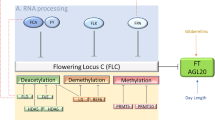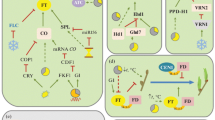Abstract
As early as in 1936, the comprehensive studies of flowering led M.Kh. Chailakhyan to the concept of florigen, a hormonal floral stimulus, and let him establish several characteristics of this stimulus. These studies set up for many years the main avenues for research into the processes that control plant flowering, and the notion of florigen became universally accepted by scientists worldwide. The present-day evidence of genetic control of plant flowering supports the idea that florigen participates in floral signal transduction. The recent study of arabidopsis plants led the authors to conclusion that the immediate products of the gene FLOWERING LOCUS I, its mRNA and/or protein, move from an induced leaf into the shoot apex and evoke flowering therein.
Similar content being viewed by others
References
Chailakhyan, M.Kh., On the Mechanism of Photoperiodic Reaction, Dokl. Akad. Nauk SSSR, 1936, vol. 1, pp. 89–93.
Chailakhyan, M.Kh., On the Hormonal Theory of Plant Development, Dokl. Akad. Nauk SSSR, 1936, vol. 3, pp. 443–447.
Chailakhyan, M.Kh., New Facts for Hormonal Theory of Plant Development, Dokl. Akad. Nauk SSSR, 1936, vol. 4, pp. 79–83.
Garner, W.W. and Allard, H.A., Effect of the Relative Length of Day and Night and Other Factors of the Environment on Growth and Reproduction of Plants, J. Agric. Res., 1920, vol. 18, pp. 553–606.
Chailakhyan, M.Kh., Gormonal’naya teoriya razvitiya rastenii (Hormonal Theory of Plant Development), Moscow: Akad. Nauk SSSR, 1937.
Salisbury, F.B. and Ross, C.W., Plant Physiology, Belmont: Wadsworth. Publ., 1999.
Taiz, L. and Zeiger, E., Plant Physiology, Sunderland: Sinauer Assoc., 1998.
Nešković M., Konjević R., Ćulafić L., Fiziologija Biljaka (Plant Physiology), Beograd: NNK-International, 2003.
Medvedev, S.S., Fiziologiya rastenii (Plant Physiology), St. Petersburg: St.-Petersburg Univ., 2004.
Kuznetsov, V.V. and Dmitrieva, G.A., Fiziologiya rastenii (Plant Physiology), Moscow: Vysshaya Shkola, 2005.
Geschichte der Biologie — Teorien, Methoden, Institutionen, Kurzbiographien, Heidelberg-Berlin: Spectrum Academischer Verlag, 2000.
Chailakhyan, M.Kh., Principles of Ontogenesis and Physiology of Flowering in Higher Plants, Can. J. Bot., 1961, vol. 39, pp. 1817–1841.
Chailakhyan, M.Kh., Faktory generativnogo razvitiya rastenii. 25-e Timiryazevskoe chtenie (Factors of Plant Reproduction, the 25th Timiryazev Lecture), Moscow: Nauka, 1964.
Chailakhyan, M.Kh., Internal Factors of Plant Flowering, Annu. Rev. Plant Physiol., 1968, vol. 19, pp. 1–36.
Chailakhyan, M.Kh., Mechanisms of Ontogenesis and Physiology of Flowering in Higher Plants, Izv. Akad. Nauk SSSR, Ser. Biol., 1960, no. 2, pp. 206–229.
Chailakhyan, M.Kh., Grigor’eva, N.Ya., and Lozhnikova, V.N., Effect of Extracts from the Leaves of Flowering Tobacco Plants on Flowering of Chenopodium rubrum Seedling, Fiziol. Rast. (Moscow), 1977, vol. 24, pp. 773–776 (Sov. Plant Physiol., Engl. Transl.).
Chailakhyan, M.Kh., Lozhnikova, V., Seidlova, F., Krekule, I., Dudko, N., and Negretsky, V., Floral and Growth Responses in Chenopodium rubrum L. to an Extract from Flowering Nicotiana tabacum L., Planta, 1989, vol. 178, pp. 143–146.
Milyaeva, E.L. and Romanov, G.A., Molecular Genetics Returns to Basic Postulates of the Florigen Theory, Fiziol. Rast. (Moscow), 2002, vol. 49, pp. 492–499 (Russ. J. Plant Physiol., Engl. Transl., pp. 438–444).
Huang, T., Böhlenius, H., Eriksson, S., Parcy, F., and Nilsson, O., The mRNA of the Arabidopsis Gene FT Moves from Leaf to Shoot Apex and Induces Flowering, Science, 2005, vol. 309, pp. 1694–1696.
Abe, M., Kobayashi, Y., Yamamoto, S., Daimon, Y., Yamaguchi, A., Ikeda, Y., Ichinoki, H., Notaguchi, M., Goto, K., and Araki, T., FD, a bZIP Protein Mediating Signals from the Floral Pathway Integrator FT at the Shoot Apex, Science, 2005, vol. 309, pp. 1052–1055.
Wigge, P.A., Kim, M.C., Jaeger, K.E., Busch, W., Schmid, M., Lohmann, I.U., and Weigel, D., Integration of Spatial and Temporal Information during Floral Induction in Arabidopsis, Science, 2005, vol. 309, pp. 1056–1059.
Chailakhyan, M.Kh., Autonomous and Induced Mechanisms of Flowering Regulation in Plants, Fiziol. Rast. (Moscow), 1975, vol. 22, pp. 1265–1282 (Sov. Plant Physiol., Engl. Transl.).
Bernier, G. and Perilleux, C.A., Physiological Overview of the Genetics of Flowering Time Control, Plant Biotechnol. J., 2005, vol. 3, pp. 3–16.
Chailakhyan, M.Kh., Regulyatsiya tsveteniya vysshikh rastenii (Regulation of Flowering in Higher Plants), Moscow: Nauka, 1988.
Muradov, A., Cremer, F., and Coupland, G., Control of Flowering Time: Interacting Pathways as a Basis for Diversity, Plant Cell, 2002, vol. 14, pp. 111–130.
Welch, S.M., Dong, Z., and Roe, J.L., Modelling Gene Networks Controlling Transition to Flowering in Arabidopsis, Rev. Cell Dev. Biol., 2004, vol. 99, pp. 519–550.
Hayama, R. and Coupland, G., Shedding Light on the Circadian Clock and the Photoperiodic Control of Flowering, Curr. Opin. Plant Biol., 2003, vol. 6, pp. 13–19.
Takada, S. and Goto, K., TERMINAL FLOWER 2, an Arabidopsis Homolog of HETEROCHROMATIN PROTEIN 1 Counteracts the Activation of FLOWERING LOCUS T by CONSTANS in the Vascular Tissues of Leaves to Regulate Flowering Time, Plant Cell, 2003, vol. 15, pp. 2856–2865.
An, H., Roussot, C., Suarez-Lopez, P., Corbesier, L., Vincent, C., Pineiro, M., Hepworth, S., Muradov, A., Justin, S., Turnbull, C., and Coupland, G., CONSTANS Acts in the Phloem to Regulate a Systemic Signal That Induces Photoperiodic Flowering of Arabidopsis, Development, 2004, vol. 131, pp. 3615–3626.
Turnbull, C.G.N., Booker, J.P., and Leyser, H.M.O., Micrografting Techniques for Testing Long-Distance Signalling in Arabidopsis, Plant J., 2002, vol. 32, pp. 255–262.
Turnbull, C. and Justin, S., Graft-Transmission of Floral Signals in Arabidopsis, Flowering Newslett., 2004, no. 37, pp. 3–10.
Ayre, B.G. and Turgeon, R., Graft-Transmission of Floral Stimulant Derived from CONSTANS, Plant Physiol., 2004, vol. 135, pp. 2271–2278.
Colasanti, J. and Sundaresan, V., “Florigen” Enters the Molecular Age: Long-Distance Signals That Cause Plants to Flower, Trends Biochem. Sci., 2000, vol. 25, pp. 236–240.
Author information
Authors and Affiliations
Additional information
Original Russian Text © N.P. Aksenova, E.L. Milyaeva, G.A. Romanov, 2006, published in Fiziologiya Rastenii, 2006, Vol. 53, No. 3, pp. 449–454.
Rights and permissions
About this article
Cite this article
Aksenova, N.P., Milyaeva, E.L. & Romanov, G.A. Florigen goes molecular: Seventy years of the hormonal theory of flowering regulation. Russ J Plant Physiol 53, 401–406 (2006). https://doi.org/10.1134/S1021443706030174
Received:
Issue Date:
DOI: https://doi.org/10.1134/S1021443706030174




